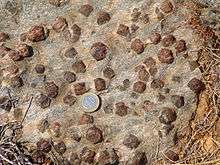Porphyroblast

A porphyroblast is a large mineral crystal in a metamorphic rock which has grown within the finer grained groundmass. Porphyroblasts are commonly euhedral crystals, but can also be partly to completely irregular in shape.
The most common porphyroblasts in metapelites (metamorphosed mudstones and siltstones) are garnets and staurolites, which stand out in well foliated metapelites (such as schists) against the platy mica matrix.
A similar type of crystal is a phenocryst, a large crystal in an igneous rock. Porphyroblasts are often confused with porphyroclasts, which can also be large outstanding crystals, but which are older than the matrix of the rock.
If a porphyroblastic mineral has small inclusions of minerals within it, the mineral is described as poikiloblastic. This observation can help interpret deformation history.
A rock which has many porphyroblasts is described as having a porphyroblastic texture.
As porphyroblasts grow, the foliation may be preserved as oriented inclusions trapped by the porphyroblast as it overgrows them, and this is helpful for tracking changing deformation planes.
In metamorphic rocks that experience deformation during metamorphism, porphyroblasts may grow before, during, or after the phase of deformation recorded by the matrix minerals. The relationship of porphyroblast growth to deformation is typically evaluated by comparing the shape orientation of trails of mineral inclusions in the porphyroblast to the matrix fabric.
Some garnet porphyroblasts contain various curving trails of quartz and other mineral inclusions. The question of whether porphyroblasts (and garnet in particular) rotate during metamorphism and deformation has long been the subject of debate. Whereas most researchers are convinced that porphyroblast may rotate during deformation, some believe that porphyroblasts do not rotate. As they grow, the foliation is preserved in their crystal structure, which is helpful for tracking changing deformation planes.
